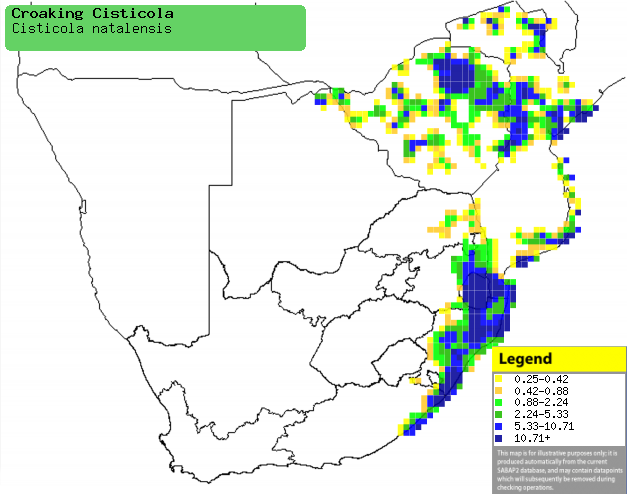|
Cisticola natalensis (Croaking
cisticola)
Groottinktinkie [Afrikaans]; Igabhoyi, Ubhoyi-bhoyi
[Xhosa]; iBhoyi [Zulu]; Harudeve (generic term for cisticola or prinia) [Kwangali];
Timba (generic name for cisticolas and warblers) [Shona]; Matinti (generic term
for cisticola) [Tsonga]; Natalgraszanger [Dutch]; Cisticole striée [French];
Strichelzistensänger [German]; Fuinha do Natal [Portuguese]
Life
> Eukaryotes >
Opisthokonta
> Metazoa (animals) >
Bilateria >
Deuterostomia > Chordata >
Craniata > Vertebrata (vertebrates) > Gnathostomata (jawed
vertebrates) > Teleostomi (teleost fish) > Osteichthyes (bony fish) > Class:
Sarcopterygii (lobe-finned
fish) > Stegocephalia (terrestrial
vertebrates) > Tetrapoda
(four-legged vertebrates) > Reptiliomorpha > Amniota >
Reptilia (reptiles) >
Romeriida > Diapsida > Archosauromorpha > Archosauria >
Dinosauria
(dinosaurs) > Saurischia > Theropoda (bipedal predatory dinosaurs) >
Coelurosauria > Maniraptora > Aves
(birds) >
Order: Passeriformes > Family: Cisticolidae
> Genus: Cisticola
Distribution and habitat
Occurs across much of sub-Saharan Africa, with one
population in West Africa from Gambia to Gabon, and another extending from
Ethiopia through Tanzania, Zambia and Angola to southern Africa. Here it is
locally common in open, moist grassland and seasonally flooded grassy
depressions with scattered bushes and trees. It may also occasionally be found
in gardens and along forest edges with grass.
|
 |
|
Distribution of Croaking cisticola in southern
Africa, based on statistical smoothing of the records from first SA Bird
Atlas Project (©
Animal Demography unit, University of
Cape Town; smoothing by Birgit Erni and Francesca Little). Colours range
from dark blue (most common) through to yellow (least common).
See here for the latest distribution
from the SABAP2. |
Food
It mainly eats invertebrates, gleaning prey from the
undergrowth and bare soil. The following food items have been recorded
in its diet:
Breeding
- It builds an oval or ball-shaped framework with a side entrance from
living grass, which it then fills in with dry grass. It is typically placed
in a large tuft of green grass close to the ground surface. It may build
several nests in total, but it only uses one in the end.
- Egg-laying season is from October-March.
- The chicks are fed a variety of insects, staying in the nest for about
14-15 days.
Threats
Not threatened.
References
-
Hockey PAR, Dean WRJ and Ryan PG 2005. Roberts
- Birds of southern Africa, VIIth ed. The Trustees of the John Voelcker
Bird Book Fund, Cape Town.
|
